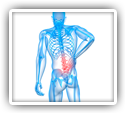
Study: Spinal Manipulation Helps Patients with MRI-confirmed Lumbar Disc Herniation
Print Article

A study published on May 17, 2018, in the journal Chiropractic & Manual Therapies, showed that spinal manipulation helped patients who had MRI confirmed disc herniations and sacro-illiac problems. The study, which did not involve chiropractors, showed that generalized spinal manipulation helped subjects suffering from back pain who had a disc herniation.
The study starts by noting that low back problems commonly include disc prolapse, spinal stenosis and low back pain. Disc herniations can be categorized into three types. The first is a disc protrusion without tearing of the fibers holding the interior of the disc intact. The second type is an extrusion, where the interior of the disc is pushed out of the disc, but is held in place by the ligaments behind the disc. The third type is called sequestration. This is where the disc materials escape into the spinal canal. Approximately 95% of all low back disc herniations occur at the last two discs in the spine, the L4-L5 level or the L5-Sacrum level.
This study was conducted by the Physical Therapy Department, School of Rehabilitation Sciences, Shiraz University of Medical Sciences, Shiraz, in Iran. The spinal manipulation applied to the subjects was given by physical therapists.
In this study, 11 men and 9 woman who had MRI confirmed disc herniations were included. All subjects had been suffering with pain in their lower back or down their leg for between one and ten months. Prior to any treatment, all patients were examined and rated for pain intensity and functional disability. All patients in this study also had restriction of movement in their sacrto-illiac joints as measured by orthopedic and functional testing.
After the initial examination, the patients received five sessions of spinal manipulation delivered by therapists on alternate days. The type of manipulation given was a generalized, non-specific twisting thrust to the lower spine that can create a popping sound. The outcomes of these treatments were evaluated after the 1st and 5th visits, and then again at a 1-month follow-up.
The results showed a statistically significant improvement for both pain and functional movement seen at the 5th visit, as well as at the 1-month follow-up visit. The orthopedic tests performed also documented objective improvements in the patients.
In their discussion, the authors of the study noted, "Our findings suggest that five sessions of lumbar and SIJ (sacro-iliac joint) manipulation can lead to statistically significant improvement in pain and functional disability, which in turn may restore normal SIJ mobility in these patients."
The authors of the study also noted that spinal manipulation was much safer than other forms of treatment for lower back and leg pains. They reported that "Compared to common treatments for LDH, SMT is reported to be 37,000 to 148,000 times safer than nonsteroid antiinflammatory drugs and 55,500 to 444,000 times safer than surgery."
Dr. Robert Braile, a chiropractor and past president of the International Chiropractors Association commented about this study. "The spinal manipulation in this study was non-specific and not applied by trained Doctor of Chiropractic. Even with this limitation, the results showed that the procedure was effective and safe. One can only imagine the added benefit that would have resulted if trained chiropractors, applying specific spinal adjustments, were utilized in this study. The results would have been even more profoundly positive."
Print Article

